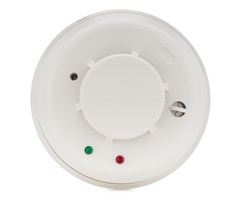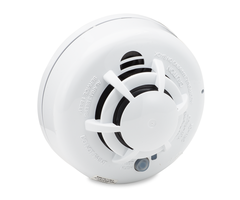How A Photoelectric Smoke Detector Works
Posted By Michael GorisReliability is the single most important factor for a smoke detector. It is critical that these devices quickly and accurately respond whenever there is a fire in the building. One of the best ways to ensure this reliability is with a smoke detector that utilizes photoelectric technology.
Photoelectric smoke detectors are some of the most popular life-safety devices available today. The defining feature of a photoelectric sensor is its internal light source and sensing chamber. By default, light will never fall on the internal photo sensor. The presence of smoke or other airborne particles will cause the light to refract, which will have it strike the sensor and produce an alarm. This means that the device will not activate suddenly, as long as the sensing chamber stays clear.
But when smoke enters the sensing chamber, the light inside the sensor will be refracted. This will cause the internal light to strike the photoelectric sensor. When this happens, the smoke detector will send an alert to the system to let it know that there is smoke (and therefore a fire) in the building. The alarm system will then perform the programmed response by alerting others to the fire.
Overall, this method is very effective for detecting fires. But with this process, there are a few things to keep in mind to ensure that a smoke works properly. It is possible that other airborne materials besides smoke can also enter the inside of the smoke detector, adjust the light source and cause an alarm. Airborne particles can also potentially prevent the detector from allowing smoke to refract the internal light onto the sensor. If this happens the smoke detector will not function as it should.
To prevent this from happening, users should make sure to place their photoelectric smoke detectors in appropriate areas. They should not be facing any vents or air ducts. Photoelectric smoke detectors should also not be placed in garages, bathrooms, kitchens or laundry rooms. This is because these rooms feature large amounts of humidity and dust that may prevent the sensor from detecting smoke.
Instead, we recommend placing photoelectric smoke detectors in large open areas where their function will not become disrupted. Some ideal locations include large central living rooms, near staircases, in hallways and outside of sleeping areas. Since smoke rises, all photoelectric smoke detectors should be installed high up on the wall or on the ceiling. By following these guidelines, a photoelectric smoke detector is more likely to work properly. For more information on the proper placement of smoke detectors, please review this helpful guide. Users should also make sure to test their photoelectric smoke detector on a regular basis and to replace the batteries when low.
Some of the most popular photoelectric smoke detectors we offer include the Honeywell 5808W3, the Honeywell SiXSMOKE and the 2GIG SMKT3-345. These are all extremely versatile smokes that also double as heat detectors. Of course, users must make sure that they smoke they choose is compatible with their alarm system. Assuming that it is a wireless smoke, it must communicate at a frequency that is accepted by their system. We hope that you will check out our selection of photoelectric smoke detectors so that you can protect your home or business.




